Yesterday’s live coverage of the Ukraine conflict can be found here. An archive of our liveblogs can be found here. For an overview and analysis of this developing story see our latest podcast.
Please help The Interpreter to continue providing this valuable information service by making a donation towards our costs.
View Ukraine: April, 2014 in a larger map
For links to individual updates click on the timestamps.
For the latest summary of evidence surrounding the shooting down of flight MH17 see our separate article: Evidence Review: Who Shot Down MH17?
Nikolai Kolesnik of Krivoy Rog, advisor to Dnepropetrovsk Governor Ihor Kolomoyskyi and patron of the 40th Battalion of Territorial Defense of the Ukrainian forces, reported on his Facebook page at 10:11 am on January 25 that the men of the 20th Battalion were taken prisoner near Krasny Partizan. The Interpreter has a translation:
Our neighbors who were serving in the 20th battalion were taken prisoner in the village of Krasny Partizan. The prisoner exchange will be handled by the Ruban Center (“Officers Corps” ) and representatives of the ATO (Anti-Terrorist Center). On their side, Darya Morozova, the ombudsman of the so-called DNR will be involved in the exchange.
A request to the volunteers, to those concerned: do not try to load up either side in the process now with requests, advice, etc. etc. Without the personal order of Zakharchenko, no one will be given up. Excessive agitation will provide a reason for speculation, and as experience has shown, will not bring real help. Strength of spirit to the guys. Patience to the relatives and loved ones.
Yury Yuryevich Varfolomeyev, 1984
Aleksandr Nikolayevich Beryemenno, 1972
Oleg Alekseyevich, 1981
Sergei Anatolyevicn Stepanov, 1981
Belishev, 1972.PS
Aleksandr Viktorovich Shebets, 1987, Nikolayevka
Dmtry Vladimirovich Zuyev, 1976, Dnepropetrovsk
Aleksandr Aleksandrovich Filippov, 1985, Dnepropetrovsk
Yury Aleksandrovich Yanitsky, 1978, NikopolThese men are in captivity. There are 5 more who were killed, we will get the exact names.
I urge all Internet publications who take information from my page not to write crap. I am not the commander of the Krivbass 40th Battalion. [Earlier, lb.ua had misreported his position; he is in fact not a military commander, but a patron of the 40th Battalion and an advisor to Dnepropetrovsk Region Governor Ihor Kolomoyskiy–The Interpreter].
Then later at 11:59 on January 25, Kolesnik reported on his Facebook:
The names of the guys from the 20th Battalion who were defending the checkpoint near Krasny Partizan:
Albert Georgiyevich Sarukhonyan of Krivoy Rog
Sergei Stanislavovich Slesarenko of Dneprodzerzhinsk
Roman Nikolayevich Sekh of Pokrovka, Krivorozhsky District
Andrei Vladimirovich Kolesnik of Chumaki, Krivorozhsky Rayon.Father Dmitry of the 20th Battalion himself came to pick up the 200s [dead] at the scene and is involved in helping the 300s [wounded] who are prisoners of the DNR fighters, a man of rare courage.
God rest the souls of our heroes.
Kolesnikov did not make any mention in either post of the allegation that some of the POWs had been executed, and was expecting an exchange of those who remained alive.
He did not indicate who the fifth prisoner was who had died, but it was likely a wounded POW.
In the comments to his post, one man notes that the men guarding the checkpoint had only one BMP and no binoculars. Militants from Gorlovka had come and threatened them with destruction a number of times, he said.
According to a news report in polit.ru, on January 24, DNR forces attacked the Krasny Partizan checkpoint located between Donetsk and Gorlovka. Ukrainian forces were proposed to leave the surrounded village or surrender.
“As a result of the ensuing battle, several Ukrainian soldiers were killed, and the rest retreated or surrendered into captivity,” said polit.ru.
— Catherine A. Fitzpatrick
The Parliamentary Assembly of the Council of Europe (PACE) has granted immunity to Nadia Savchenko, the Ukrainian pilot who was captured by Russian-backed forces, kidnapped to Russia, and charged with the murder of two Russian journalists in eastern Ukraine (see our earlier discussion of Savchenko below). What’s interesting about this development, however, is that Russia is a member of PACE and so, under this decision, would be bound to release Savchenko. RFE/RL reports:
PACE says Savchenko’s immunity obligates Russia to release her immediately from pretrial detention in Moscow, where she is being held on suspicion of contributing to the death of two Russian journalists during a military operation in eastern Ukraine…
A report in Ukrainska Pravda cited unnamed sources at the PACE session as suggesting the Russian delegation had officially stated it supported the decision to release Savchenko.
If true, the statement represents an apparent about-face from the delegation’s previous position.
As of writing this, it remains unclear if and when Savchenko will be released from prison, however.
A video of POWs taken after a battle in Krasny Partizan, along with soldiers who had died was uploaded to YouTube on January 24.
[Warning: graphic]:
Most of the POWs are from the town of Krivoy Rog, Dnepropetrovsk or other towns in the Dnepropetrovsk Region. They had all been drafted in the army.

The interrogator asks them all their names and towns of origin and then also points to some men in the line with them who are wounded or already dead.
There has been some concern that some of these POWs have been executed and those still alive may still await execution.
While that is always possible, we do not believe that the available evidence in the dialogue, the behavior of the prisoners, and the setting, proves that those who have died were executed.
There are holes in the wall which has led some to theorize these could be bullet holes. But they could be bullet holes but from shooting at another time, or perhaps just broken plaster. There are purported bullet holes behind the heads of some of the men who are still alive, possibly indicating that these are the result of a battle rather than an execution:
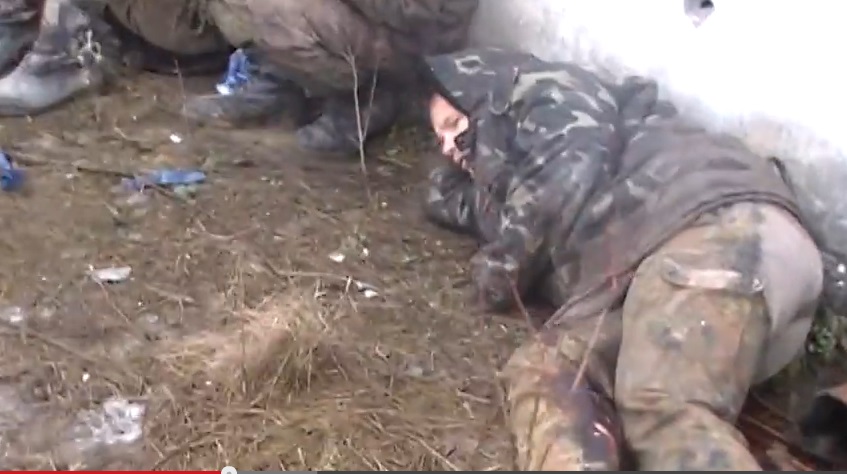
Furthermore, one of the men lying on the ground does not have any head wound. Another who is wounded and barely able to say his name also has no head wound. Only one man in the video has a head wound.
A second video [warning: graphic] evidently related to the first appears to show some of the same men, two of the same dead men and a third man who was the balding wounded man in the first video, barely able to say his name, who is now dead in the second video.
In the second video, the unit’s name on the patches on their jackets is Rabovladeltsy which means “Slaveholders” in Ukrainian.
In the dialogue in the first video, the interrogator never threatens the POWs with execution or refers to those who are dead in the scene as having been executed.
The men in the line-up do not appear to be totally preoccupied or in shock as they might be expected if they were facing execution, although they do appear exhausted and reluctant to speak, and some of them have bleeding lacerations on their heads or hands.
Several times, the interrogator/camera man inquires whether someone is dead or live, but if he had been executed, the cameraman would have already been certain of his status.
Here is a translation by The Interpreter of an excerpt start at 0:57:
Interrogator: Here. A 300 [wounded] or a 200 [dead].
Fighter: Is that a 300? Huh?
Interrogator: It looks like it
Fighter: He doesn’t answer.
Fighter: I think that one’s a 200 already.
Interrogator: That one’s already gone. He’s finished. Or is he still alive? No. And here’s another one. That’s how it is. And they came to us.
Fighter: Here’s another one.
Interrogator. Where’s another one?
Fighter: Over here.
Interrogator: Is he alive?
Fighter: He’s wounded.
Interrogator: Last name!
Prisoner: Huh?
Interrogator: Last name!
Prisoner: Belyshev.
Interrogator: Where are you from?
Prisoner: From Krivoy Rog.
Interrogator: Krivoy Rog. What year were you born?
Prisoner: 1972.
Interrogator: What?
Prisoner: ’72.
Interrogator: ’72. Great guy. Well, we’ll wait. So these guys came to us.
The prisoners, while understandably in a grim position, do not appear overly scared, and take an interest in whether their fellow prisoner who was wounded has died yet. They also answer all the questions asked of them.
The following is a another excerpt of the dialogue starting at 4:14, translated by The Interpreter:
Interrogator: Do you have a family?
Prisoner: Of course I do.
Interrogator: Married?
Prisoner: Married. Two daughters.
Interrogator: Two daughters. So you came to die here?
Prisoner: [hangs his head]
Interrogator: With two daughters. Yes?
Prisoner: No.
Interrogator: Then why?
[Goes to the next prisoner]
Interrogator: And you? Do you have a family? Who?
Prisoner: A wife and two children.
Interrogator: Two children as well. And you came here to die here for your
two children? And how will they be now?
[Goes to next prisoner]
Interrogator: And you?
Prisoner: A wife and two children.
Interrogator: Oh! Everybody has a pair.
[Goes to next prisoner.]
Prisoner: Also a wife and two children.
Interrogator: And yet another! Shit. What great guys here!
[Goes to another prisoner.]
Prisoner: A wife and one daughter.
Interrogator: A daughter. How old is she?
Prisoner: 10.
Interrogator: 10! And what will she tell you, her father?
Prisoner: [hangs his head]
Interrogator: And what about you?
Prisoner: I don’t have a family. I have an elderly mother.
Interrogator: An elderly mother. Then she can castigate you.
[Goes to the next prisoner]
Prisoner: A wife and two children.
Interrogator: Two again. Great guys! Do you want to send any greetings to your relatives? Huh? You don’t want to say anything? To your wife and children?
Prisoner: That I love them very much.
Interrogator: Does anybody else want to say anything? Or you don’t want to say anything.
Prisoners: We love them very much.
Interrogator: They love you a lot, too. But you came here to kill our
children. Huh?
Another Separatist: Is there anyone from the Donbass?
[Prisoners shake their heads]
Interrogator: Oh, no, they’re all from Dnepropetrovsk Region, Krivoy Rog. You came to kill our children.
Prisoner: No.
Interrogator: Then why did you come here?
Prisoner: We were mobilized.
Interrogator: You were mobilized. So you could give a fuck. You can kill children. You can bomb cities.
Prisoner: You can’t.
Interrogator: Then why did you come here?
Prisoner: We were guarding the checkpoint.
Interrogator: Well. So your friends did, then. And what about him? He probably has children. That 300. Or 200. [wounded or dead, respectively – The Interpreter] Or whatever he is, over there. Well? Do you know at least what his name was?
Prisoners: [looking over at him] Roman.
Interrogator: From Krivoy Rog, too?
Prisoner: From Dnepropetrovsk Region.
Interrogator: Did he have children, too?
Prisoner: [nods].
Interrogator: Roman is now gone. And here’s another one, on his way out. He probably has children, too.
Prisoner: He doesn’t, no.
Interrogator: Well, thank God, they won’t cry then.
The Russian-backed separatists in the video reiterate a message we have seen in dozens of similar videos of POWs for the last months, used in war propaganda:
o the draftees are Russian-speakers or Russians like the separatists and therefore the implication is that they shouldn’t be going to war against the separatists;
o they were mobilized, and didn’t volunteer, so there is still hope to appeal to their fellow draftees to resist the draft
o an attempt is made to shame them by telling them of civilians who have been killed by shelling, especially children;
o the point is made that the land that the POWs have been arrested on is the “land of the separatists,” and the Ukrainian soldiers should not have “trespassed” on it.
While the interrogator asks the prisoners whether they have come to the Donbass to die, consistent with past films of this nature, the context is the implication that they will die in battle, not that they will be executed.
A third video (warnining: graphic) shows the former Ukrainian checkpoint at Krasny Partizan that the Russian-backed separatists have taken over.
In this third video about the battle, at 0:58, a soldier tells the Russian state news channel Rossiya 24 that there were “4 200s,” i.e. those killed in action and the rest were taken captive. That suggests that they died in a firefight, not that they were executed.
A Cossack at 1:37 says they offered the men the opportunity to surrender, they refused, and they didn’t want to leave, either.
As the Cossack explains at 2:05, this was a strategic checkpoint on an important road to control the area, because it leads to Gorlovka. He mentions Right Sector fighters that “held out to the end”. He claims that the wounded prisoners were taken to the hospital, that one was picked up by his wife, and that they gave them food and cigarettes. He said “they are safe, and we promised the war is over for them if Poroshenko doesn’t call them up again.” But it is not clear what happened to the POWs.
— Catherine A. Fitzpatrick
today that reportedly involved the spotter for the Russian commander of a unit with
Grad rockets which were fired on Mariupol, killing 30 and injuring more
than 90 on January 24.
In the video, Valery Sergeyevich Kirsanov discusses the shelling of Mariupol with a fighter named “Pepel” (Ash). The Interpreter has a translation:
Kirsanov: Yes.
Pepel:
Aleksandr, well, you really, really, really overdid it. It’s gone on
the homes, the nine-story apartment buildings, the private sector, the
Kievsky Market, in short…
Pepel: Oh, no…
The Ukrainian Authorities were then able to arrest Kirsanov and
obtain a confession from him on videotape (translated by The Interpreter). We note that because Kirsanov
is in custody his statements may be coerced.
I am Valery Sergeyevich Kirsanov, resident
of Mariupol, born in 1975. About six years ago, I made the acquaintance
of Sergei Leonidovich Ponomarenko. At the present time, Ponomarenko is
the commander of the 1st Slavic Company of the Novorossiya Army. His
call sign is “Terrorist”. I knew that he was fighting on the side of the
DNR, but even so, I kept in touch with him.
Under the
subordination of Terrorist is a reconnaissance and artillery infantry.
Ponomarenko called me about a month ago and asked me in the event of any
questions coming up, if connection was lost with him, to call a man
with the call sign “Pepel” [Ash] and he would solve any issues that came
up for me regarding [inaudible] and here the connection would be with him.Pepel
called me two weeks ago and asked for the coordinates where there was a
concentration of the Ukrainian Armed Forces. Up until the end of 2014, I
worked in the GAI [traffic police] and I knew visually where the armor
of the active forces of the UA forces were. I knew they were within the
bounds of the city and adjacent areas. I used the Google Earth program to get
the coordinates which [inaudible] I gave to Pepel.During
the whole time I was in touch with him, I sent the coordinates of the
Vinogradny, Petrovsky Trass and Taganrogsky checkpoints to him.Interrogator: And after that, there was shelling of these checkpoints?
Kirsanov: Yes, there was shelling.
Interrogator: Of all of those sites?
Kirsanov:
Almost all of them. As for the Taganrogsky Checkpoint, I gave the
coordinates yesterday by SMS. They were supposed to work this at night,
but they worked it in the morning.Interrogator: At what time?
Kirsanov: Approximately at 8:00 am.
Interrogator: Today?
Kirsanov:
Today, yes. I came to see what had happened there and I called Pepel
and said he had missed by one kilometer. He asked, “From where is the
shooting visible?” And I said, “From the direction of Vinogradsky. So.
He said, “Well, alright.” And I said, “There were a lot of people.” And
then the connection…I said, “A lot of people were killed,” and with
that, the connection with him broke off.Interrogator: That’s clear. Who fired on the Vostochny micro-district today?
Kirsanov: Pepel’s unit.
Interrogator: So you’re certain of that.
Kirsanov: Yes. Pepel is an officer of the Russian [Federation] Army and is head of the artillery battalion.
As we reported, Prime Minister Aleksandr Zakharchenko of the self-proclaimed “Donetsk People’s Republic” first announced that
the Russian-backed separatists were launching an offensive on Mariupol
— then when he found out civilians were killed, denied it.
— Catherine A. Fitzpatrick
Kyiv Post reports:
On Jan. 26, activists in Kyiv held a performance in a protest against imprisonment of Ukrainian female officer Nadiya Savchenko, 33, in a Russian prison.
A volunteer of the Aidar Battalion, she was captured on June 17 in Luhansk Oblast, refused to cooperate with Kremlin-backed separatists and illegally taken to Russia in what supporters says are trumped-up charges of being involved in the murders of two Russian journalists in the Donbas war. Savchenko denies all the accusations and is currently on the hunger strike.
RFE/RL adds that the Russian State Duma’s speaker, Sergei Naryshkin, has refused to intervene and says that only the court system will judge Savchenko:
Naryshkin, speaking on January 25 after a meeting with Brasseur, said Savchenko’s fate was up to Russia’s courts.
Naryshkin said, “Only an investigation and the court can establish guilt; and if guilt is not proven, then she will be freed.”
Critics say Russian courts do the Kremlin’s bidding.
Savchenko is charged with the murder of two Russian journalists in eastern Ukraine. However, Savchenko is a pilot, and those journalists were killed by shelling, and thus almost-certainly had no role in their deaths. Furthermore, Savchenko is considered by most of the international community to be a prisoner of a war, meaning that she may have been kidnapped to Russia specifically to face these charges.
The OSCE Permanent Council is meeting now and will be discussing Savchenko, according to the U.S. Ambassador to the OSCE:
An extremely graphic video was
uploaded January 22 to YouTube showing Givi, commander of the Somalia
Battalion of the Russian-backed separatist forces of the self-proclaimed
“Donetsk People’s Republics” (DNR).
Givi, a commander who has been popularized in hundreds of Russian
state TV broadcasts and “Novorossiya” YouTube channels, is shown pistol-whipping,
beating, threatening and screaming at Ukrainian POWs evidently arrested
after the fall of the Donetsk Airport to separatists on January 21.
The first scenes in the video have been geolocated here on Google Maps to the separatists’ stronghold in the north of Donetsk right across from the airport, a location where many war propaganda videos have been made.
Givi grabs the POWs from a truck and throws them to the ground by a yellow house with a brick wall in the apartment complex taken over by the separatists last fall.
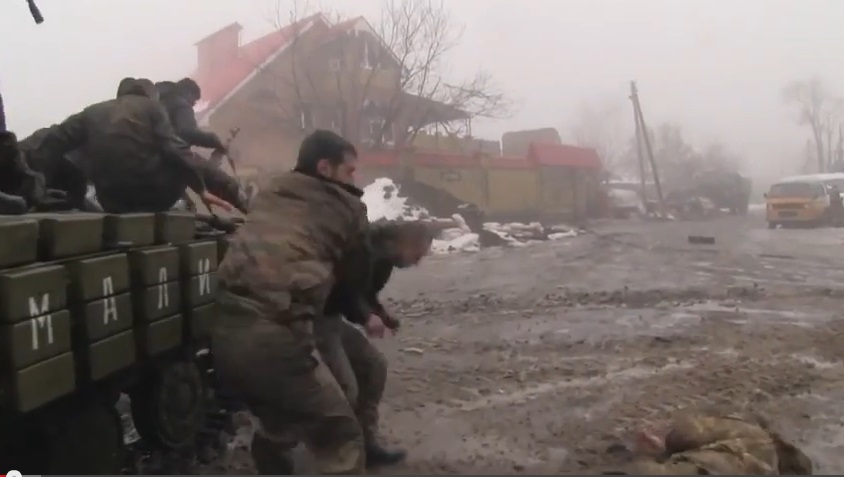
The same house on Google Street View:
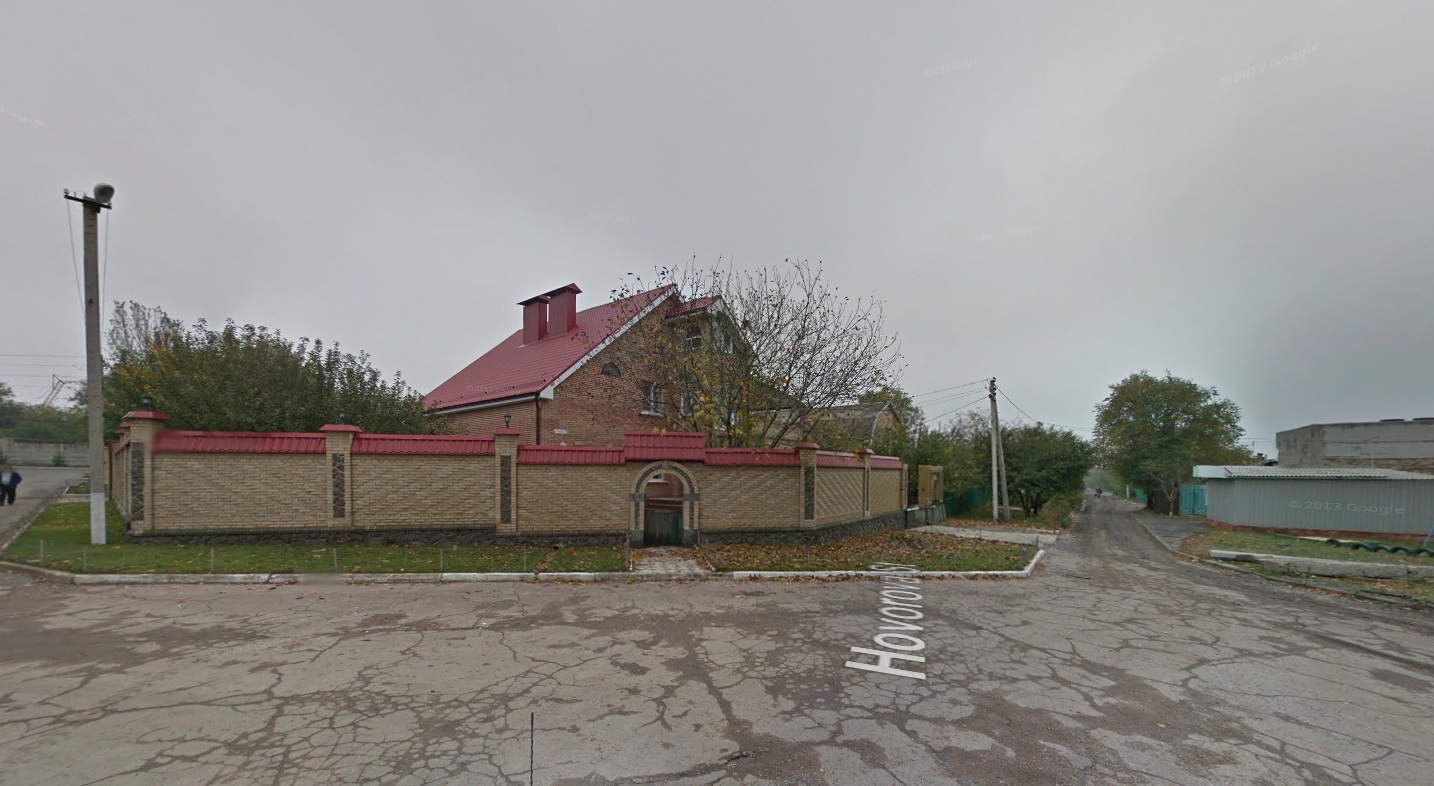
Open News Room’s Donie O’Sullivan noted that bald man seen in the line-up of POWs and clearly at 4.12 in the video is Col. Oleg Mitsaka, captured during the battle for Donetsk airport, according to news reports.
Throughout the video, we can see Russian state and pro-Kremlin TV crews filming the interrogation of the POWs, which as Dunja Mijatovic, OSCE’s Representative for Media Freedom has declared an “unethical and inadmissible” journalistic practice.
Yevgeny Poddubny, special correspondent for Rossiya-24 TV, is visible in the video with a “Press” sign on his chest and helmet; we have seen him many times before in footage from the Donetsk Airport.
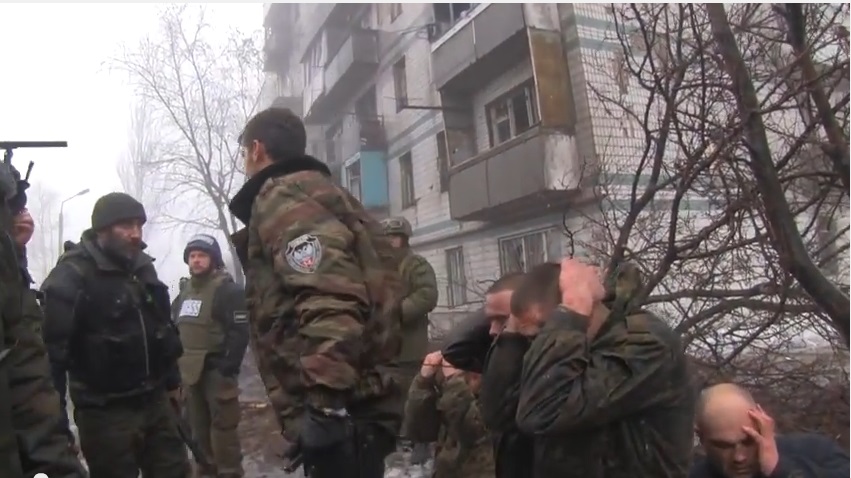
A LifeNews microphone is also seen thrust into the POWs’ faces:
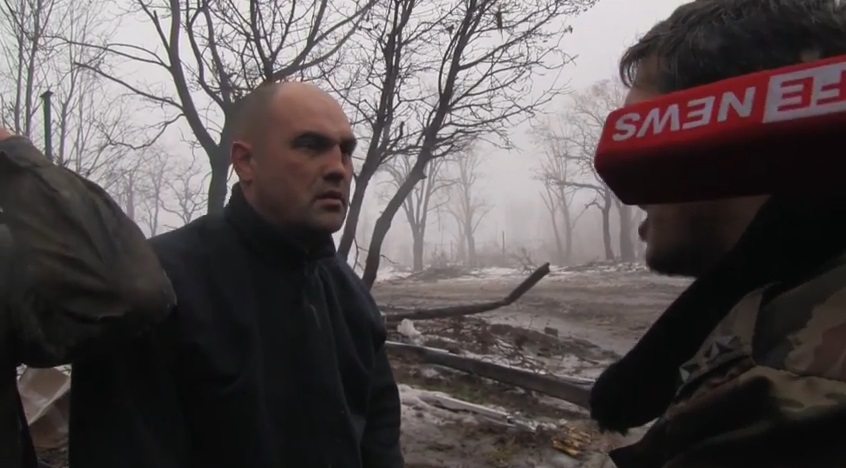
At the separatists’ stronghold near the airport, Givi asks the POWs if they recognize him and they say “yes.”
All of the POWs say they were drafted, not volunteers, and come from Zhitimir, Vinnitsa, Chernihiv and other regions. At 1:48, Givi asks for a knife, cuts off the chevron of the Ukrainian soldier and then forces him to eat it. Then he does the same to several other prisoners, finally unsheathing and brandishing a large saber.
Givi tells the men, shaking from cold, that they are lucky to be alive. By 3:04, we can see the men bruised and bloody, and clearly they have been beaten. The POWs are repeatedly asked why they came to “the separatists’ land” and shelled on the city.
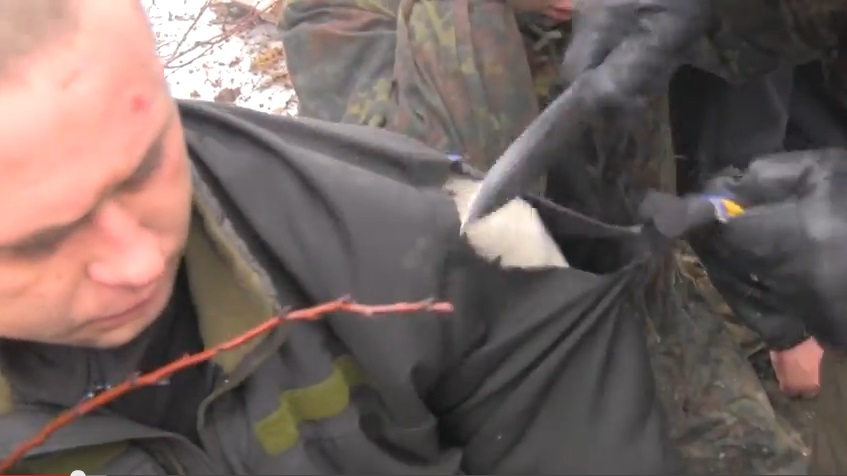
Mitsaka, described as “the main Cyborg,” as the soldiers defending the airport were known, has the rank of colonel. Givi points to the city of Donetsk and says to Mitsaka “You have done this,” regarding the shelling of the city and grabbing his head forcefully says that a 6-week old baby was left an orphan after shelling of the apartment building in the background, and demands that Mitsaka look him in the eyes.
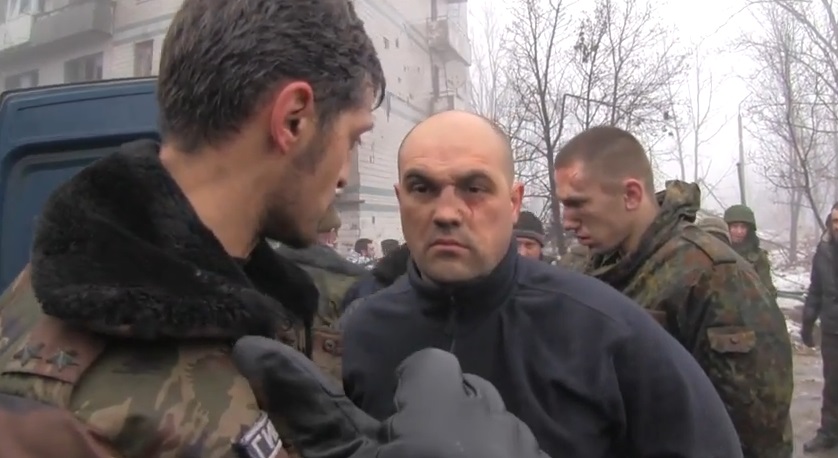
Givi threatens to organize reprisals in Zhitomir in retaliation for what he believes has been perpetrated by the Ukrainian forces in Donetsk.
The POWs are blindfolded and pushed into a van. Mitsaka is asked how much his salary is per month, and he says “10,000 hyrvnias” (US $640).
Viktor Babenko, a Ukrainian POW said they were given orders to pick up wounded but when they came to the airport they found they had to be in an offensive against the airport.
Givi notes that from Babenko’s crew, 3 were killed and 2 were taken prisoner and 5 surrendered. Asked if he understood what Ukrainian forces had done in Donetsk, Babenko answered in Ukrainian that the knew, and Givi said he would “let him stay alive for that” and trade him for a separatist POW. Babenko was then forced to tell his story to LifeNews, and said that he thought he was just picking up wounded men but found himself in battle.
Babenko is then forced to make an appeal to other Ukrainians not to serve in the army and refuse to join up.
At 8:40, the separatists unload at least three dead soldiers. At 8:58 we can glimpse the lettering on the armored jeep, and it appears to be “PR” in Russian, which would match with “LDPR,” or the ill-named ultranationalist “Liberal Democratic Party of Russia” headed by the notorious Vladimir Zhirinovsky, who has repeatedly bragged about giving jeeps to the Russian-backed separatist army.
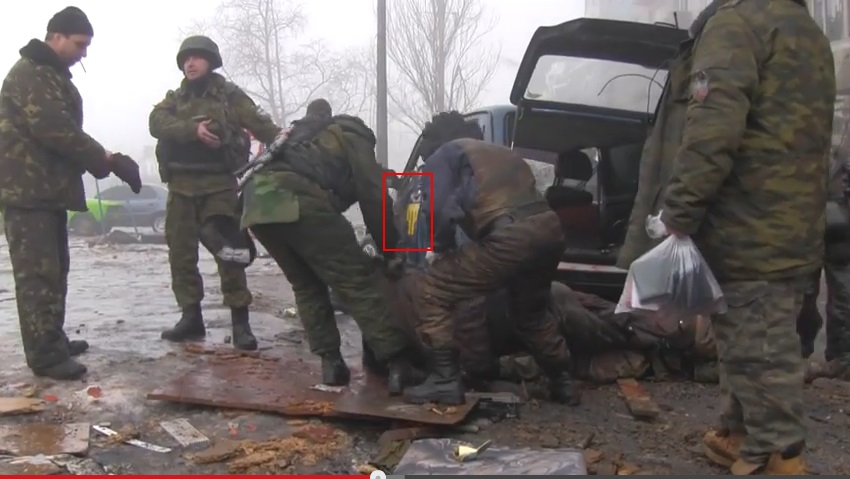
Later, a total of six dead soldiers are shown, evidently killed in battle at the airport, at least one with the top of his head blown off.
At 9:52, a soldier says 81st Brigade, 90th battalion a newly-formed unit. A separatist demands to know if he is from Right Sector, and he denies it, and says their brigade was just formed December 22 and they were sent to Konstantinovka.
The POWs are then taken into the city of Donetsk and paraded around and angry townspeople shout at them about how they have suffered from shelling, and have been forced to live in their basements.
At 14:02, a woman appears with a broom and beats a POW. She and others continue to beat the prisoners and are even held back by the separatists. Several throw eggs at the prisoners.
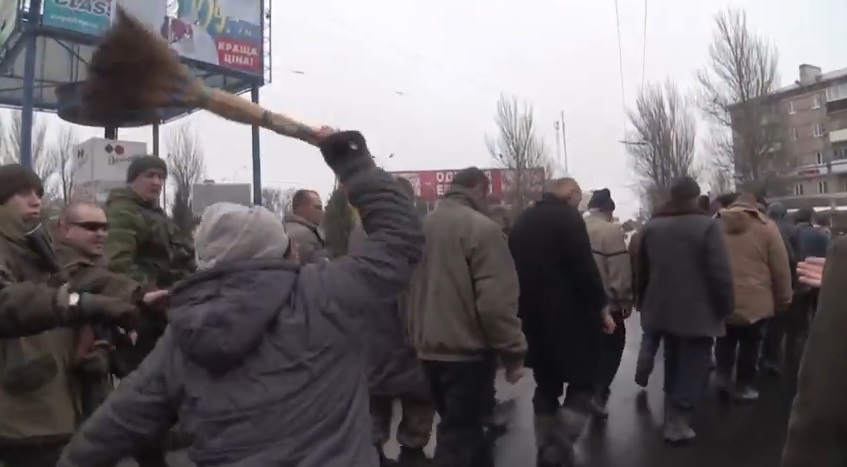
There is something of a contrived feeling to these women attackers, as
quite a few other women on the street are just standing silently with
worried expressions on their faces. So there is a possibility they were
incited or even “stage-managed” by Russian TV.
At the end, Col. Mitsaka is once again slapped around by a militant, and forced to speak to Russia’s Channel 1. But he refuses to speak, and finally says he has nothing to say.
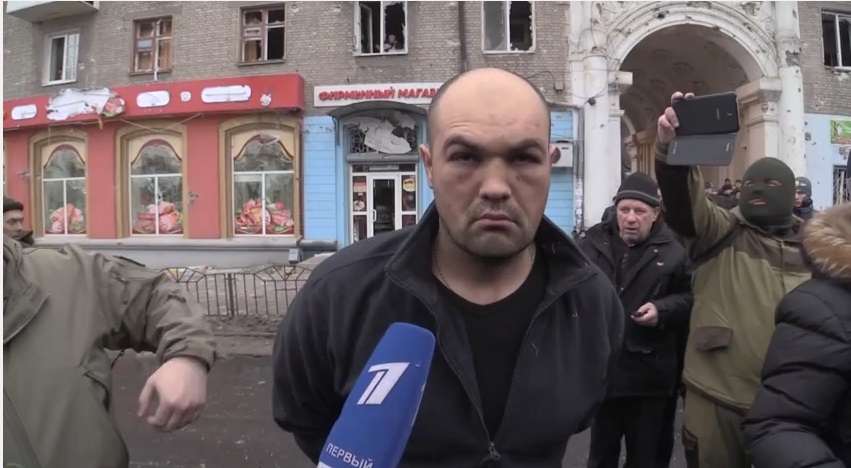
— Catherine A. Fitzpatrick and Pierre Vaux
Earlier we reported that the ATR TV Station, a Crimean Tatar station in Simferopol, was raided by masked men. We also analyzed evidence that suggests that the men may be OMON special police personnel from the Russian Interior Ministry. Read our update below.
Now the OSCE has released a statement condemning the raid:
OSCE Representative on Freedom of the Media Dunja Mijatović today condemned the raid by masked forces in Crimea on ATR television station in the city of Simferopol.
“I have repeatedly reminded of the need to safeguard the work of journalists and media outlets. This practice of intrusion of free and independent media cannot be tolerated in the OSCE region,” Mijatović said.
On 26 January masked forces raided the ATR offices and newsroom in Simferopol. They searched the premises and detained the staff of the television station. The masked forces also confiscated equipment and shut down ATR’s analogue broadcasting.
“It is crucial for the Crimean Tatars to be able to receive and obtain information and news from ATR. ATR must be allowed to resume its broadcasting as soon as possible,” Mijatović said.
The Representative’s previous statements involving ATR are available at http://www.osce.org/fom/116240 and http://www.osce.org/fom/119887.
— James Miller
Russia’s Interfax news agency reports that President Vladimir Putin has publicly accused the Ukrainian military of being a NATO proxy.
The Interpreter translates:
“We keep saying: Ukrainian army, Ukrainian army. Who in fact is fighting there? There definitely are part-official units of the armed forces, but to a great degree, they are the so-called ‘nationalist volunteer battalions,'” said Putin during a gathering with students at the National Mineral Resources University in Saint Petersburg.
He added: “In actual fact, this is no longer an army, this is a foreign legion, in this case a NATO foreign legion which, of course, does not pursue the aims of Ukraine’s national interests. It has completely different aims, and they are tied to the geopolitical goal of containing Russia, which absolutely does not coincide with the national interests of the Ukrainian people.”
Putin claimed that Kiev has made use of the (relative) lull in combat since the ceasefire to regroup its forces. He said that the “official Kiev authorities are refusing to follow the path of peaceful settlement.”
While such rhetoric as calling the Ukrainian government and armed forces pawns of the West has been common in the state-dominated Russian media, this is the first such direct accusation from the Russian head of state.
— Pierre Vaux
ATR, a Crimean Tatar television station in Simferopol, Russian-occupied Crimea, has been raided by armed and masked Russian security forces.
RFE/RL reported:
Crimean Tatar activist Eskender Bariyev wrote on Facebook that searches were conducted in the television channel’s headquarters.
ATR correspondent Shevket Namatullayev wrote on Facebook that representatives of Russia’s Federal Security Service (FSB) and Investigative Committee were talking with the channel’s management.
While most of the men have their insignia panels (on the backs of their uniform) covered, at least one is visible, confirming what their camouflage scheme and vehicle appearance would suggest, that they are OMON special police personnel from the Russian Interior Ministry.
RFE/RL reported that the channel had announced in a special broadcast that they would be complying with the occupying authorities’ demands and handing over all information requested, as they could not operate without a server in the event that the office was shut down.
RFE/RL’s Crimean service reported that the building’s WiFi had been switched off. Employees suggested that this was done in an attempt to prevent information about the raid being distributed on social media.
Speaking live on-air, Lilya Budzhurova, the deputy director-general of political reporting at ATR, who fears that the occupying Russians wanted to shut down the station, said (translated by The Interpreter):
“I do not how, after the closure of ATR, if there are such plans, the government will be able to look Crimean Tatars in the face? I don’t know how these actions correspond with the Russian president’s order on the rehabilitation of deported peoples, including the Crimean Tatars.”
She claimed that the Russian security services were carrying out the raid in order to remove any evidence related to a protest rally on February 26 last year against the Russian occupation.
Budzhurova concluded:
“Because of this we are not saying goodbye, but are watching the course of events and the next acts from the local authorities, who, I hope, are aware of what a blow they will land, not only on the Crimean Tatars, but also on their own reputation. And the reputation of the federal government.”
— Pierre Vaux
There are reports online that Ukrainian-held Avdeyevka is under heavy fire today.
Translation: #Avdeyevka shells are falling in the centre of the town! Putin, die you beast!
Translation: #Avdeyevka many impacts, shelling continues. The separatists have just sent a Grad. Came under fire.
Translation: They say the shelling’s continuing. It’s targeting the civilians, it hasn’t been striking military sites.
Translation: One killed, six wounded. Reports to be confirmed.
Novosti Donbassa also reported one dead.
According to their summary, based on reports from local residents, shells have struck residential areas, including Kommunalnaya street, Jubilee street and Shevchenko boulevard. One shell fell near a kindergarten, though there was no information on whether any children were on the site. The town has been left without water, electricity or heating.
— Pierre Vaux
Mariupol news site 0629.com.ua reports that the Ukrainian military headquarters in the port city has announced that Russian-backed forces have attacked Ukrainian positions this morning.
Dmitry Chaly, press officer for the headquarters, said that Russian-backed fighters had resumed their attacks with mortar fire, aimed at the Ukrainian-held village of Nikolaevka at 8 this morning (6:00 GMT).
Yesterday, attacks had begun at 10:00 with small arms fire reported near Chermalyk.
At 12:00, Ukrainian positions near Sartana, just outside Mariupol, to the north-east, came under artillery bombardment. Half an hour later, mortars struck Ukrainian positions outside Nikolaevka.
In the evening, between 19:00 and 19:20, Ukrainian positions near Orlovskoye were shelled with artillery.
Chaly claimed that their had been no Ukrainian military casualties.
Here is a map of these locations:
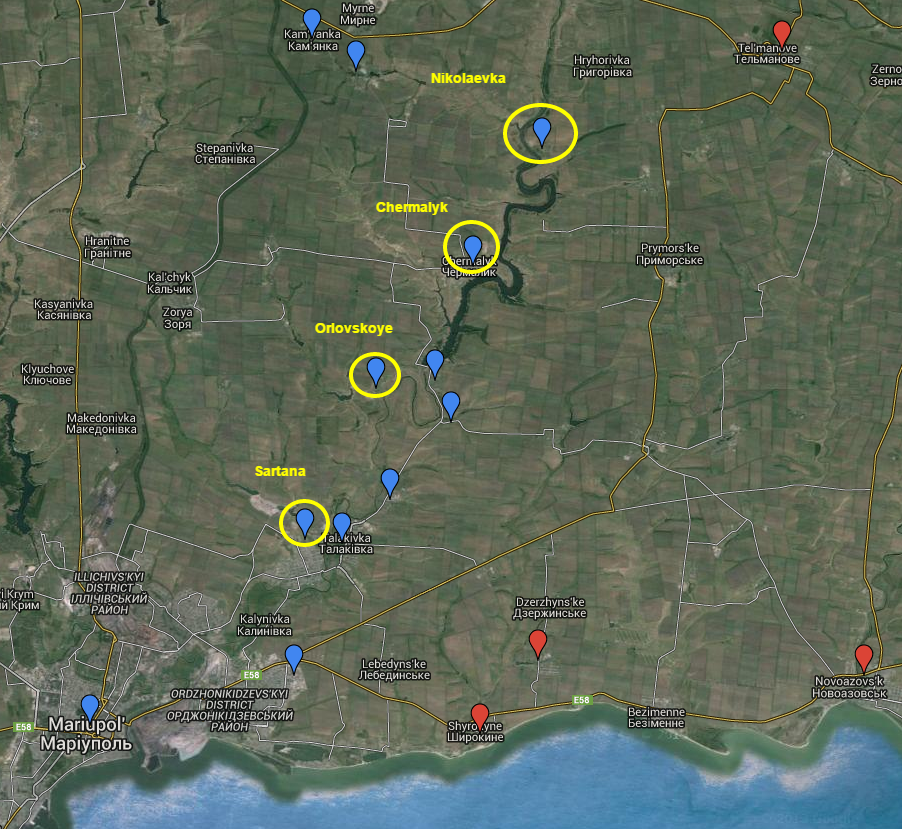
In Mariupol itself, the local authorities announced that children would not be attending classes in the Vostochniy area (the furthest west blue marker within the bounds of Mariupol itself on the map above). This was the area devastated by Grad rocket fire on January 24, leaving 30 civilians dead.
0629 reported that schools no 5, 67, 68 and 69 would be closed today, with students either to learn remotely or to be move to alternate locations away from the city’s eastern limits.
Meanwhile, RBK Ukraina reports that Valentyn Nalyvaichenko, the head of the Ukrainian Security Service (SBU), has claimed at a briefing that Saturday’s attack on Vostochniy was commanded by an officer in the Russian armed forces, using the call-sign ‘Pepel’ (ash).
Nalyvaichenko claimed that a militant and resident of Mariupol, who had directed the artillery fire, has been arrested. He gave his name as Valery Kirsanov and claimed that his call-sign was ‘Gayishnik’ (i.e. from GAI, the traffic cops).
According to the head of the SBU, this detainee testified that the shelling had been conducted under the command of a Russian officer with the call-sign of ‘Pepel.’
Nalyvaichenko also claimed that, of the rocket launchers used to shell Vostochniy, some had been destroyed and some withdrawn to Russian territory.
— Pierre Vaux